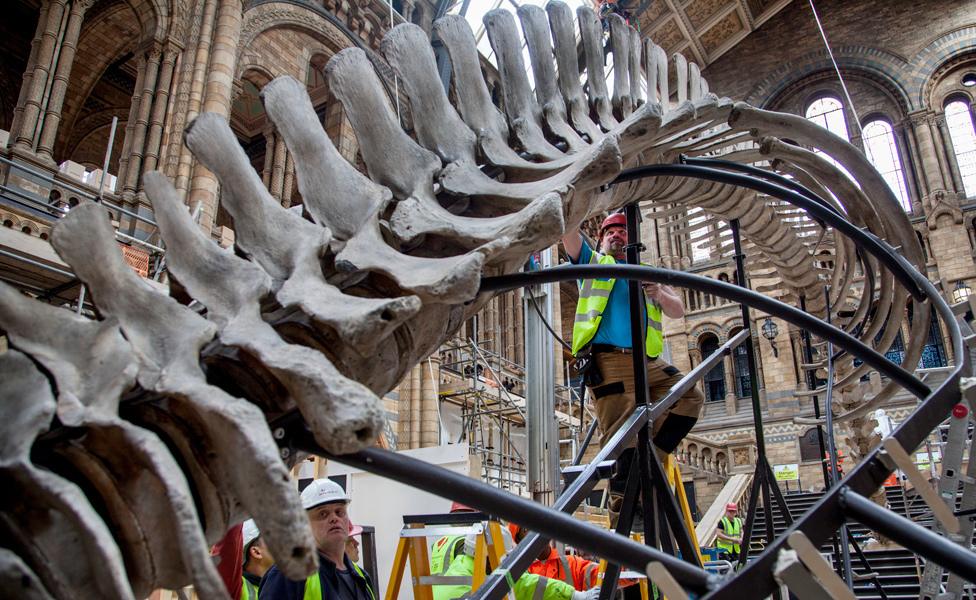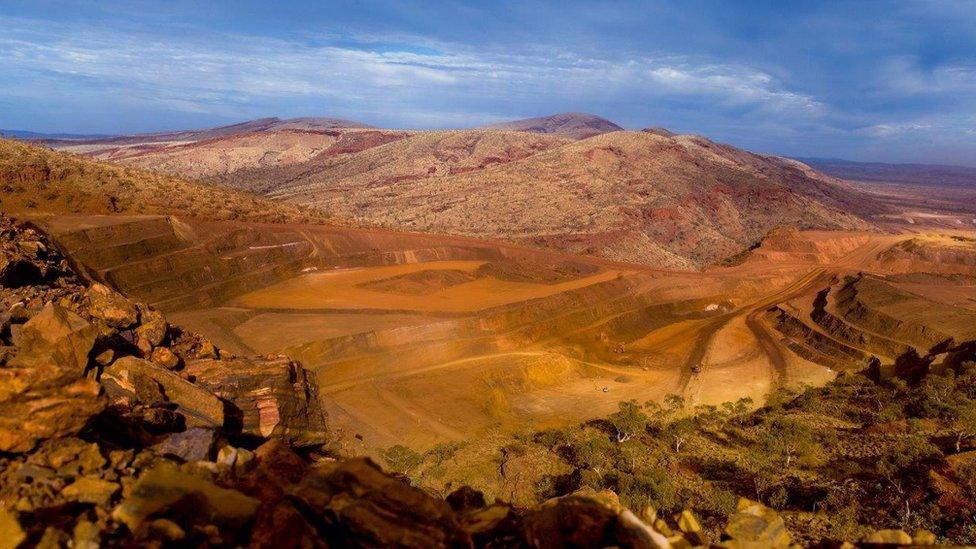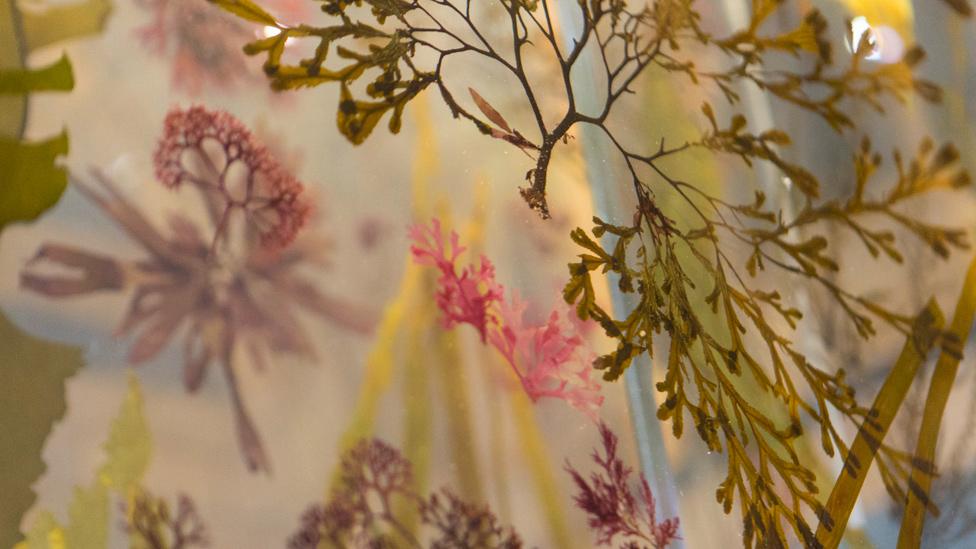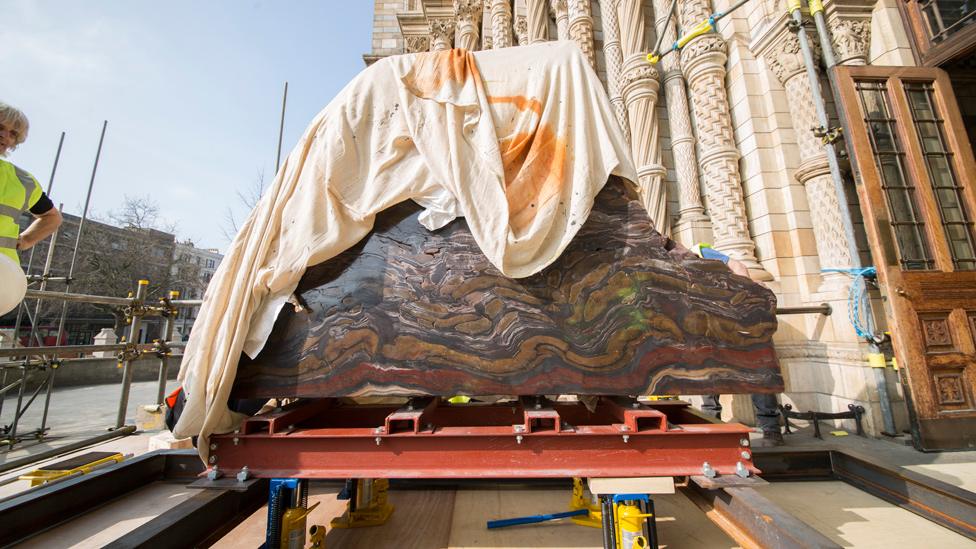The rock that records how we all got here
- Published
Richard Herrington: "It's that free oxygen that gives us the diversity of life we have on Earth today"
You're going to want to touch it; you're definitely going to want to run your fingers over its wavy lines.
This 2.5-tonne lump of rock will be one of the new star exhibits when London's Natural History Museum re-opens its front entrance-space in a couple of weeks' time.
The Hintze Hall has been closed for most of this year to allow the South Kensington attraction to remodel its welcome to visitors. Out has gone "Dippy" the diplodocus dinosaur, and in its place has come a massive skeleton of a blue whale.
From 14 July, as you go into the NHM, you'll be confronted by the largest animal on the planet diving down at you from the ceiling. Your correspondent has had a sneak peek, and it's spectacular.

The NHM's blue whale skeleton is to take centre-stage from now on
But look around the edges of the hall and you'll see its alcoves have also been refreshed. The NHM is calling them the "Wonder Bays".

The Wonder Bays aim to showcase the origins, evolution and diversity of life on Earth
I want you to head for one alcove in particular on the right, just under the whale's tail.
It'll hold a specimen of banded iron formation, or BIF.
About 2m along the base and 1.5m high, the object represents a wonderful juxtaposition between the animate (whale) and the inanimate (rock) and the very deep connection that exists between the two.
BIFs were laid down on ocean floors more than two billion years ago. They record a key chemical transition in Earth's history when oxygen started to become abundant.
It was a profound change that would ultimately make complex life - such as the giant cetaceans - possible.
Those wavy lines in the BIF are bands of iron oxide (mostly haematite) interspersed with chert (silica).

Rio Tinto donated the BIF, sourcing it from a mine in north-western Australia
Earth's early oceans would have been full of reduced iron in solution that had been washed off the continents, and when it combined with the nascent oxygen being produced by photosynthetic bacteria, the resulting oxides would have precipitated to settle on the seafloor.
The different layers incorporated into the rock probably mark cycles of bacterial boom and bust. Ultimately, all of the right type of iron in the ancient waters was consumed and the free oxygen had nowhere else to go but up and out into the atmosphere.
Earth had become a different place.
"The rock tells a fantastic story," says Prof Richard Herrington, the head of Earth sciences at the NHM.
"This is the prelude to complex life. We're oxygen breathers. An organism needs an energy source and the burning of carbon in the presence of oxygen is largely where we get our energy from. It still took two billion years from this rock to get to multicellular organisms, but that's another story," he told BBC News.

The Imilac meteorite was found in the Atacama Desert in Chile in 1822
Part of the decision to put the whale centre-stage at the museum is to highlight issues of sustainability - to get us all to think a little deeper about how we use Earth's resources.
BIFs are an important commercial material. Their iron content has helped build the modern world. The Wonder Bay rock comes from the Pilbara region in north-western Australia. Rio Tinto identified the block at one of its open-cast mines, and had it cut, polished and shipped to London.
"The piece itself is not actually ore-grade; it's got about 32% iron in it, when most of the product we produce out of the Pilbara is between 58% and 62% iron," explained Stephen McIntosh, a senior executive with Rio Tinto. "But the rock's got all the qualities and textures you'd want to see. And, as you say, it records an amazing moment in time - a time that was incredibly important for the Earth we live on today."
The BIF will be joined by nine other Wonder Bay objects, including a blue marlin, a giant Turbinaria coral and a Chilean meteorite that is regarded as one of the most beautiful ever recovered because of its large olivine crystals.

Seaweeds will feature in a Wonder Bay to highlight the incredible complexity of the Tree of Life

The rock installation is supported by the Claude and Sofia Marion Foundation
Jonathan.Amos-INTERNET@bbc.co.uk, external and follow me on Twitter: @BBCAmos, external